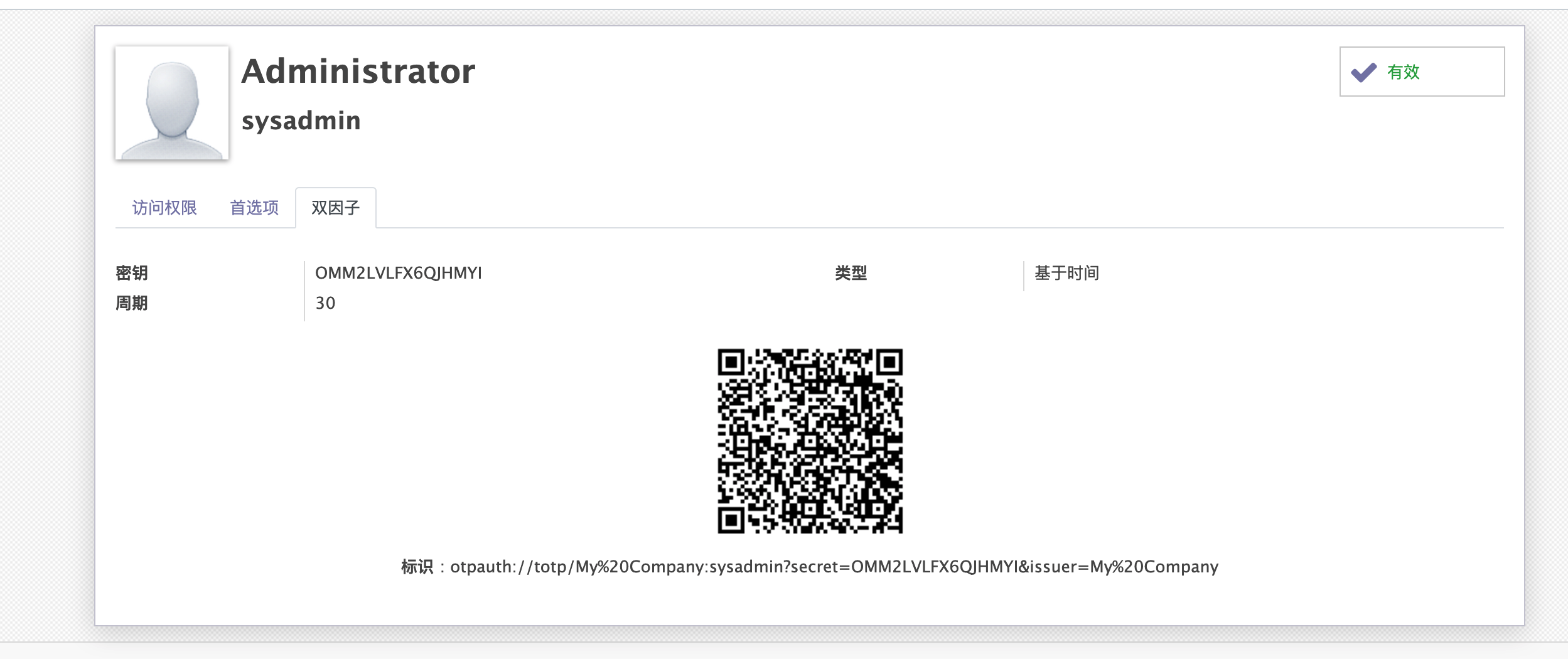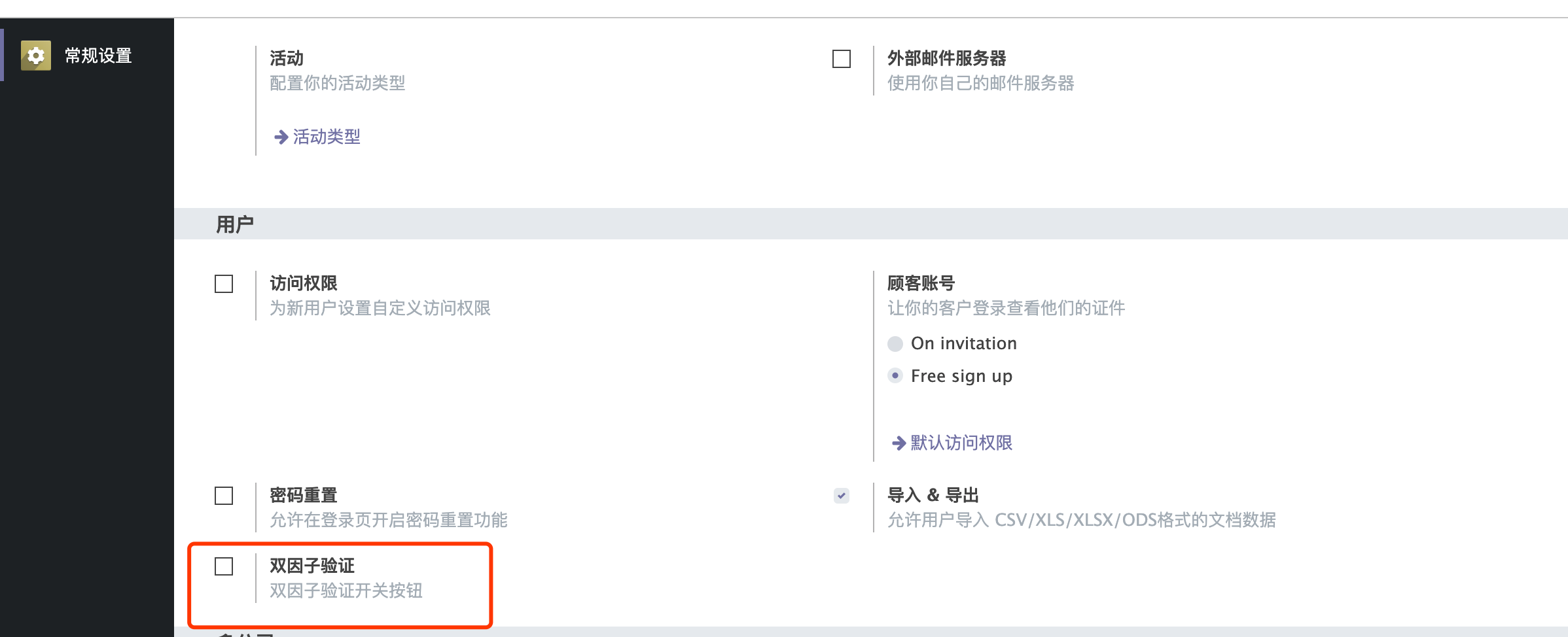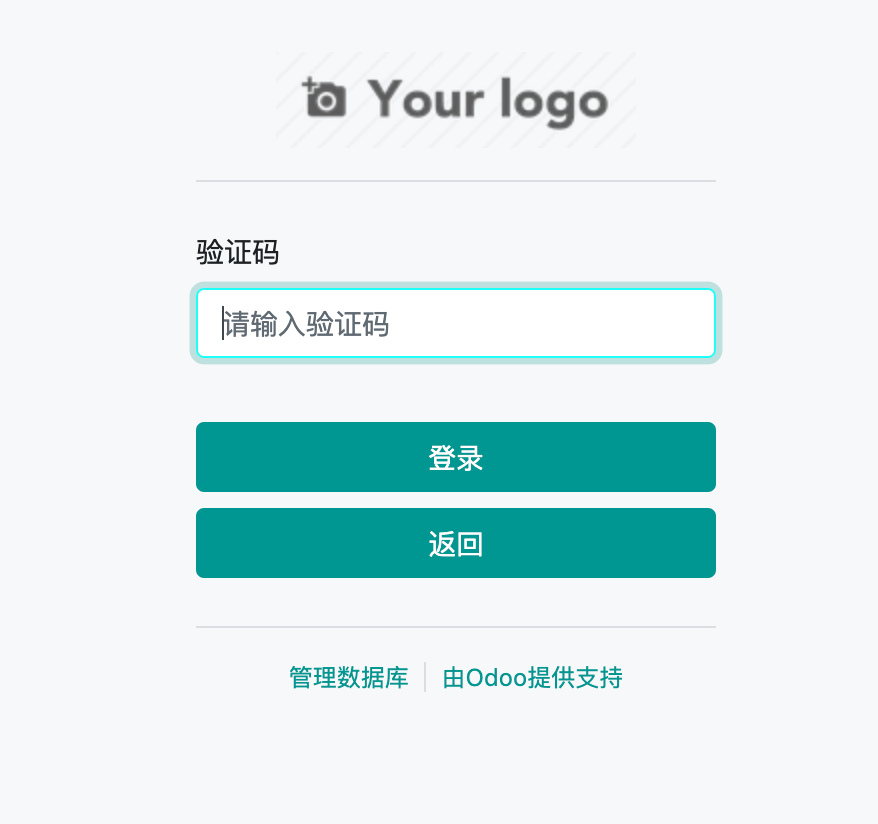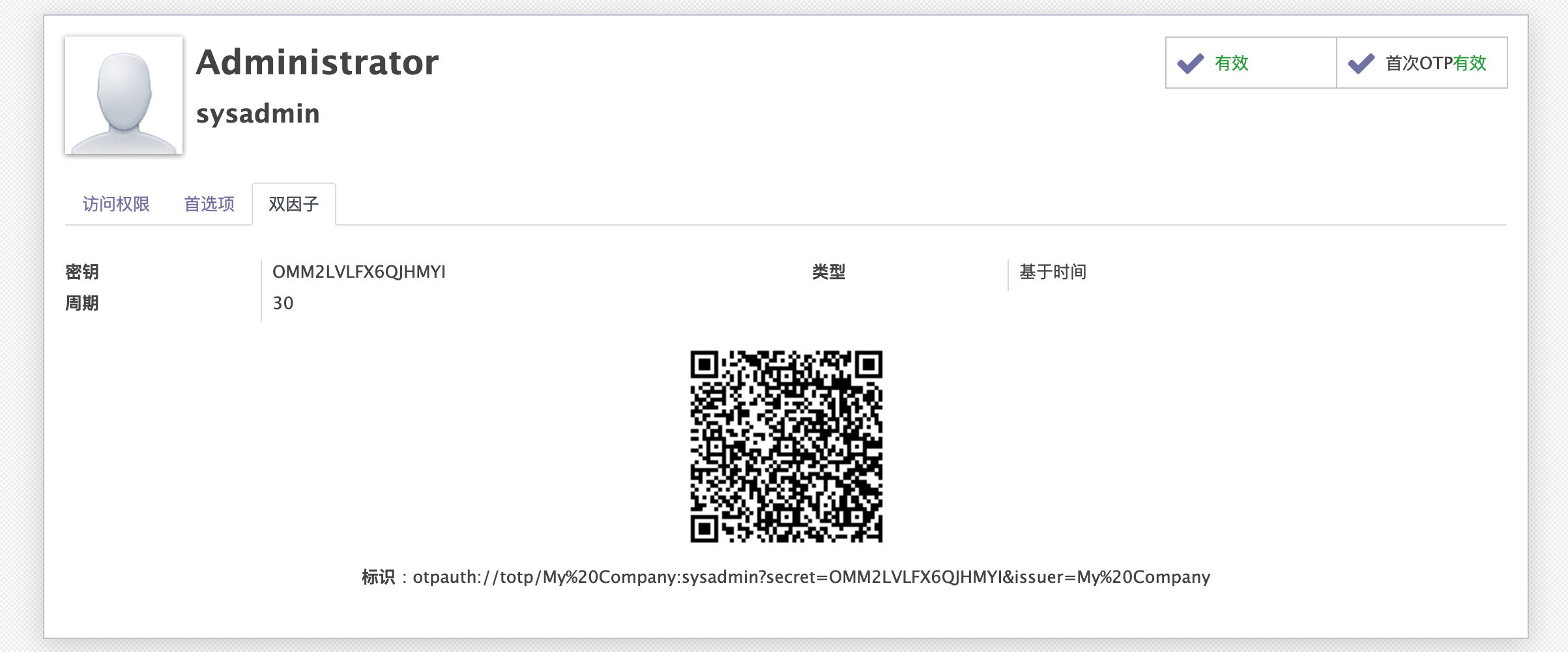odoo12之应用:一、双因子验证(Two-factor authentication, 2FA)(HOTP,TOTP)附源码
前言
双因子认证:双因子认证(2FA)是指结合密码以及实物(信用卡、SMS手机、令牌或指纹等生物标志)两种条件对用户进行认证的方法。--百度百科
跟我一样"老"的网瘾少年想必一定见过买点卡后上面送的密保(类似但不完全一样),还有"将军令",以及网银的网盾,是一种二次验证的机制;它通常是6位的数字,每次使用后(HOTP)或者一定时间后(TOTP)都将会刷新,大大加大了用户的安全性,OTP(One-Time Password)分为HOTP(HMAC-based One-Time Password)和TOTP(Time-based One-Time Password)。
HOTP是基于 HMAC 算法加密的一次性密码,以事件同步机制,把事件次序(counter)及相同的密钥(secret)作为输入,通过 HASH 算法运算出一致的密码。
TOTP是基于时间戳算法的一次性密码,基于客户端的时间和服务器的时间及相同的密钥(secret)作为输入,产生数字进行对比,这就需要客户端的时间和服务器的时间保持相对的一致性。
Odoo12集成双因子认证
为了让odoo12的登录也可以使用双因子认证以提高安全性,我们需要:
、实现OTP验证逻辑
、为ODOO用户界面展示二维码
、为管理员用户提供OTP开关
、在登录界面增加对OTP的验证
我们需要依赖的包:
pip install pyotp
pip install pyqrcode
pip install pypng
实现OTP验证逻辑
首先,我们需要对res.users用户进行重写,添加OTP验证逻辑
# -*- coding: utf-8 -*-
import base64
import pyotp
import pyqrcode
import io from odoo import models, fields, api, _, tools
from odoo.http import request
from odoo.exceptions import AccessDenied import logging _logger = logging.getLogger(__name__) class ResUsers(models.Model):
_inherit = 'res.users' otp_type = fields.Selection(selection=[('time', _('Time based')), ('count', _('Counter based'))], default='time',
string="Type",
help="Type of 2FA, time = new code for each period, counter = new code for each login")
otp_secret = fields.Char(string="Secret", size=16, help='16 character base32 secret',
default=lambda self: pyotp.random_base32())
otp_counter = fields.Integer(string="Counter", default=0)
otp_digits = fields.Integer(string="Digits", default=6, help="Length of the code")
otp_period = fields.Integer(string="Period", default=30, help="Seconds to update code")
otp_qrcode = fields.Binary(compute="_compute_otp_qrcode") otp_uri = fields.Char(compute='_compute_otp_uri', string="URI") # 生成二维码
@api.model
def create_qr_code(self, uri):
buffer = io.BytesIO()
qr = pyqrcode.create(uri)
qr.png(buffer, scale=3)
return base64.b64encode(buffer.getvalue()).decode() # 将二维码的值赋给otp_qrcode变量
@api.depends('otp_uri')
def _compute_otp_qrcode(self):
self.ensure_one()
self.otp_qrcode = self.create_qr_code(self.otp_uri) # 计算otp_uri
@api.depends('otp_type', 'otp_period', 'otp_digits', 'otp_secret', 'company_id', 'otp_counter')
def _compute_otp_uri(self):
self.ensure_one()
if self.otp_type == 'time':
self.otp_uri = pyotp.utils.build_uri(secret=self.otp_secret, name=self.login,
issuer_name=self.company_id.name, period=self.otp_period)
else:
self.otp_uri = pyotp.utils.build_uri(secret=self.otp_secret, name=self.login,
initial_count=self.otp_counter, issuer_name=self.company_id.name,
digits=self.otp_digits) # 验证otp验证码是否正确
@api.model
def check_otp(self, otp_code):
res_user = self.env['res.users'].browse(self.env.uid)
if res_user.otp_type == 'time':
totp = pyotp.TOTP(res_user.otp_secret)
return totp.verify(otp_code)
elif res_user.otp_type == 'count':
hotp = pyotp.HOTP(res_user.otp_secret)
# 允许用户不小心多点20次,但是已经用过的码则无法再次使用
for count in range(res_user.otp_counter, res_user.otp_counter + 20):
if count > 0 and hotp.verify(otp_code, count):
res_user.otp_counter = count + 1
return True
return False # 覆盖原生_check_credentials,增加双因子验证
def _check_credentials(self, password):
super(ResUsers, self)._check_credentials(password)
# 判断是否打开双因子验证并校验验证码
if self.company_id.is_open_2fa and not self.check_otp(request.params.get('tfa_code')):
# pass
raise AccessDenied(_('Validation Code Error!'))
在这里,我们继承了res.users,添加了如下方法:
_compute_otp_uri: 计算otp_uri
create_qr_code: 通过计算的otp_uri生成二维码
_compute_otp_qrcode: 调用create_qr_code生成二维码,赋值给otp_qrcode变量
check_otp: 用于验证otp验证码是否正确
_check_credentials: 覆盖原生_check_credentials,判断双因子的开关,调用check_otp进行双因子验证
_check_credentials方法中,我们判断了双因子的开关,而双因子开关是以公司为单位的,因此我们还需要对res.company进行继承添加字段:
# -*- coding: utf-8 -*- from odoo import models, api, fields class ResCompany(models.Model):
_inherit = "res.company" is_open_2fa = fields.Boolean(string="Open 2FA", default=False)
为ODOO用户界面展示二维码
我们写好逻辑后,需要在用户界面中将二维码以及配置展示出来:
<?xml version="1.0" encoding="utf-8"?>
<odoo>
<data>
<!-- 设置->用户&公司->用户界面-->
<record id="view_users_form" model="ir.ui.view">
<field name="name">res.users.form</field>
<field name="model">res.users</field>
<field name="inherit_id" ref="base.view_users_form"/>
<field name="arch" type="xml">
<notebook colspan="4" position="inside">
<page string="2FA">
<group col="4" colspan="4">
<field name="otp_secret"/>
<field name="otp_type"/>
<field name="otp_counter"
attrs="{'invisible':[('otp_type', '==', 'time')], 'readonly': True}"/>
<field name="otp_digits" attrs="{'invisible':[('otp_type', '==', 'time')]}"/>
<field name="otp_period" attrs="{'invisible':[('otp_type', '==', 'count')]}"/>
</group>
<div class="row" style="display: block;text-align: center;">
<field name="otp_qrcode" widget="image" nolabel="1"/>
</div>
<div class="row" style="display: block;text-align: center;">
<label for="otp_uri"/>:
<field name="otp_uri"/>
</div>
</page>
</notebook>
</field>
</record>
<!-- 右上角首选项界面-->
<record id="view_users_form_simple_modif" model="ir.ui.view">
<field name="name">res.users.preferences.form.otp</field>
<field name="model">res.users</field>
<field name="inherit_id" ref="base.view_users_form_simple_modif"/>
<field name="arch" type="xml">
<footer position="before">
<div class="o_horizontal_separator">OTP</div>
<div class="row" style="display:block;text-align:center">
<field name="otp_qrcode" widget="image" nolabel="1"/>
</div>
<div class="row" style="display:block;text-align:center">
<field name="otp_uri" nolabel="1"/>
</div>
</footer>
</field>
</record>
</data>
</odoo>
效果如下:

为管理员用户提供OTP开关
我们需要让OTP可以为管理员配置,我们将它加入到res.config.settings的常规设置中:
首先,继承模型添加关联字段,is_open_2fa与company_id里的is_open_2fa关联:
# -*- coding: utf-8 -*- from odoo import fields, models class ResConfigSettings(models.TransientModel):
_inherit = 'res.config.settings' is_open_2fa = fields.Boolean(related='company_id.is_open_2fa', string="Open 2FA", readonly=False)
然后,我们将它展示到常规设置->用户当中
<?xml version="1.0" encoding="utf-8"?>
<odoo>
<record id="res_config_settings_view_form" model="ir.ui.view">
<field name="name">res.config.settings.view.form.inherit.base.setup</field>
<field name="model">res.config.settings</field>
<field name="priority" eval="100"/>
<field name="inherit_id" ref="base.res_config_settings_view_form"/>
<field name="arch" type="xml">
<xpath expr="//div[@id='user_default_rights']" position="inside">
<div class="col-12 col-lg-6 o_setting_box">
<div class="o_setting_left_pane">
<field name="is_open_2fa"/>
</div>
<div class="o_setting_right_pane">
<label for="is_open_2fa"/>
<div class="text-muted">
The Switch to open 2FA
</div>
</div>
</div>
</xpath>
</field>
</record>
</odoo>
效果如下:
在登录界面增加对OTP的验证
最后,我们修改登录界面,在页面中增加对otp的验证。
首先,我们需要新增输入页面:
<?xml version="1.0" encoding="utf-8"?>
<odoo>
<template id="auth_2FA.2fa_auth" name="TFA_auth">
<t t-call="web.login_layout">
<form class="oe_login_form" role="form" t-attf-action="/web/login/2fa_auth{{ '?debug' if debug else '' }}"
method="post" onsubmit="this.action = this.action + location.hash">
<input type="hidden" name="csrf_token" t-att-value="request.csrf_token()"/> <div class="form-group field-login">
<label for="tfa_code">Validation Code</label>
<input type="text" placeholder="Please input 2FA digits number" name="tfa_code" t-att-value="tfa_code" id="tfa_code"
t-attf-class="form-control #{'form-control-sm' if form_small else ''}" required="required"
autofocus="autofocus" autocapitalize="off"/>
</div> <p class="alert alert-danger" t-if="error" role="alert">
<t t-esc="error"/>
</p>
<p class="alert alert-success" t-if="message" role="status">
<t t-esc="message"/>
</p> <div t-attf-class="clearfix oe_login_buttons text-center mb-1 {{'pt-2' if form_small else 'pt-3'}}">
<button type="submit" class="btn btn-primary btn-block">Log in</button>
<button type="button" class="btn btn-primary btn-block" onclick="window.location.href='/web/login'">Return</button>
<div class="o_login_auth"/>
</div> <input type="hidden" name="login" t-att-value="login"/>
<input type="hidden" name="password" t-att-value="password"/>
<input type="hidden" name="redirect" t-att-value="redirect"/>
</form>
</t>
</template>
</odoo>
然后,我们需要对/web/login路由进行修改,更改它的跳转逻辑和验证逻辑,在controller中添加main.py:
# -*- coding: utf-8 -*-
import odoo
import logging
from odoo import http, _
from odoo.addons.web.controllers.main import ensure_db, Home
from passlib.context import CryptContext
from odoo.http import request default_crypt_context = CryptContext(
['pbkdf2_sha512', 'md5_crypt'],
deprecated=['md5_crypt'],
) _logger = logging.getLogger(__name__) class WebHome(odoo.addons.web.controllers.main.Home):
# Override by misterling
@http.route('/web/login', type='http', auth="none", sitemap=False)
def web_login(self, redirect=None, **kw):
ensure_db()
request.params['login_success'] = False
if request.httprequest.method == 'GET' and redirect and request.session.uid:
return http.redirect_with_hash(redirect) if not request.uid:
request.uid = odoo.SUPERUSER_ID values = request.params.copy()
try:
values['databases'] = http.db_list()
except odoo.exceptions.AccessDenied:
values['databases'] = None if request.httprequest.method == 'POST':
old_uid = request.uid
try:
request.env.cr.execute(
"SELECT COALESCE(company_id, NULL), COALESCE(password, '') FROM res_users WHERE login=%s",
[request.params['login']]
)
res = request.env.cr.fetchone()
if not res:
raise odoo.exceptions.AccessDenied(_('Wrong login account'))
[company_id, hashed] = res
if company_id and request.env['res.company'].browse(company_id).is_open_2fa:
# 验证密码正确性
valid, replacement = default_crypt_context.verify_and_update(request.params['password'], hashed)
if replacement is not None:
self._set_encrypted_password(self.env.user.id, replacement)
if valid:
response = request.render('auth_2FA.2fa_auth', values)
response.headers['X-Frame-Options'] = 'DENY'
return response
else:
raise odoo.exceptions.AccessDenied()
# 没有打开双因子验证
uid = request.session.authenticate(request.session.db, request.params['login'],
request.params['password'])
request.params['login_success'] = True
return http.redirect_with_hash(self._login_redirect(uid, redirect=redirect))
except odoo.exceptions.AccessDenied as e:
request.uid = old_uid
if e.args == odoo.exceptions.AccessDenied().args:
values['error'] = _("Wrong login/password")
else:
values['error'] = e.args[0]
else:
if 'error' in request.params and request.params.get('error') == 'access':
values['error'] = _('Only employee can access this database. Please contact the administrator.') if 'login' not in values and request.session.get('auth_login'):
values['login'] = request.session.get('auth_login') if not odoo.tools.config['list_db']:
values['disable_database_manager'] = True # otherwise no real way to test debug mode in template as ?debug =>
# values['debug'] = '' but that's also the fallback value when
# missing variables in qweb
if 'debug' in values:
values['debug'] = True response = request.render('web.login', values)
response.headers['X-Frame-Options'] = 'DENY'
return response @http.route('/web/login/2fa_auth', type='http', auth="none")
def web_login_2fa_auth(self, redirect=None, **kw):
ensure_db()
request.params['login_success'] = False
if not request.uid:
request.uid = odoo.SUPERUSER_ID values = request.params.copy()
try:
values['databases'] = http.db_list()
except odoo.exceptions.AccessDenied:
values['databases'] = None
old_uid = request.uid
try:
uid = request.session.authenticate(request.session.db, request.params['login'],
request.params['password'])
request.params['login_success'] = True
return http.redirect_with_hash(self._login_redirect(uid, redirect=redirect))
except odoo.exceptions.AccessDenied as e:
request.uid = old_uid
if e.args == odoo.exceptions.AccessDenied().args:
values['error'] = _("Wrong login/password")
else:
values['error'] = e.args[0]
if not odoo.tools.config['list_db']:
values['disable_database_manager'] = True if 'login' not in values and request.session.get('auth_login'):
values['login'] = request.session.get('auth_login') if 'debug' in values:
values['debug'] = True response = request.render('auth_2FA.2fa_auth', values)
response.headers['X-Frame-Options'] = 'DENY'
return response
我们新增了otp验证路由,将登录逻辑增加到otp验证路由中,然后更改login路由,增加以下逻辑:
request.env.cr.execute(
"SELECT COALESCE(company_id, NULL), COALESCE(password, '') FROM res_users WHERE login=%s",
[request.params['login']]
)
res = request.env.cr.fetchone()
if not res:
raise odoo.exceptions.AccessDenied(_('Wrong login account'))
[company_id, hashed] = res
if company_id and request.env['res.company'].browse(company_id).is_open_2fa:
# 验证密码正确性
valid, replacement = default_crypt_context.verify_and_update(request.params['password'], hashed)
if replacement is not None:
self._set_encrypted_password(self.env.user.id, replacement)
if valid:
response = request.render('auth_2FA.2fa_auth', values)
response.headers['X-Frame-Options'] = 'DENY'
return response
else:
raise odoo.exceptions.AccessDenied()
这段代码的作用是判断otp是否开启并进行密码验证(不登录,不生成session),通过密码验证跳转到otp验证页面。效果如下:

增加语言支持
由于使用的是英文,我们需要增加中文翻译支持。
Tip:需要中文翻译的语句在非字段描述中需要使用_进行包裹,如:
_("Wrong login/password")
打开开发者模式,设置->翻译->导出翻译->选择简体中文,PO文件,要导出的应用为two factor authentication。新建auth_2FA/i18n目录,将导出的文件复制到i18n目录下,修改里面英文内容对应的中文内容后,重启服务器即可生效。
如果没有生效,请在设置->翻译->加载翻译中重新加载。
TODO
对于第一次使用的用户,在用户登录时,在登录界面中展示二维码。实现方案:为res.users增加"是否第一次使用"字段,在第一次登录后展示二维码,并为其赋值为True。具体的逻辑有兴趣的朋友可以先行尝试实现。
APP下载
功能需要配套app使用,请自己手机搜索"谷歌验证器"下载使用,或使用其他可用otp软件替代。
代码地址
从github中下载:
git clone https://github.com/lingjiawen/auth_2FA.git
从odoo官方app中下载:https://apps.odoo.com/apps/modules/12.0/auth_2FA/
声明
原文来自于博客园(https://www.cnblogs.com/ljwTiey/p/11505473.html)
转载请注明文章出处,文章如有任何版权问题,请联系作者删除。
代码仅供学习使用,未经作者允许,禁止使用于商业用途。
合作或问题反馈,联系邮箱:26476395@qq.com
---------------------------------以下为9月12号更新----------------------------------
新增对于第一次使用的用户,在用户登录时,在登录界面中展示二维码。实现方案:为res.users增加"是否第一次使用"字段,在第一次登录后展示二维码,并为其赋值为True,已更新至github和app store,效果如下:


odoo12之应用:一、双因子验证(Two-factor authentication, 2FA)(HOTP,TOTP)附源码的更多相关文章
- Remote验证及其改进(附源码)
Remote验证及其改进(附源码) 表单中的输入项,有些是固定的,不变的验证规则,比如字符长度,必填等.但有些是动态的,比如注册用户名是否存在这样的检查,这个需要访问服务器后台才能解决.这篇文章将会介 ...
- 强制禁用gitlab的双因子认证:Two-Factor Authentication
(一)问题描述: 此博客解决如下问题:禁用gitlab的双因子认证 禁用前,如图(此时,你在gitlab中什么也干不了) (二)思路分析: 百度了很多方法,都不可靠(如不可靠的说明:https://s ...
- Java钉钉开发_02_免登授权(身份验证)(附源码)
源码已上传GitHub: https://github.com/shirayner/DingTalk_Demo 一.本节要点 1.免登授权的流程 (1)签名校验 (2)获取code,并传到后台 (3) ...
- JAVA WEB项目中生成验证码及验证实例(附源码及目录结构)
[我是一个初学者,自己总结和网上搜索资料,代码是自己敲了一遍,亲测有效,现将所有的目录结构和代码贴出来分享给像我一样的初学者] 作用 验证码为全自动区分计算机和人类的图灵测试的缩写,是一种区分用户是计 ...
- Asp.net MVC验证哪些事(3)-- Remote验证及其改进(附源码)
表单中的输入项,有些是固定的,不变的验证规则,比如字符长度,必填等.但有些是动态的,比如注册用户名是否存在这样的检查,这个需要访问服务器后台才能解决.这篇文章将会介绍MVC中如何使用[RemoteAt ...
- 利用js编写一个简单的html表单验证,验证通过时提交数据(附源码)
<!DOCTYPE html> <html lang="en"> <head> <meta charset="UTF-8 ...
- ASP.NET Core & 双因素验证2FA 实战经验分享
必读 本文源码核心逻辑使用AspNetCore.Totp,为什么不使用AspNetCore.Totp而是使用源码封装后面将会说明. 为了防止不提供原网址的转载,特在这里加上原文链接: https:// ...
- (诊断)解决GitHub使用双因子身份认证“Two-Factor Athentication”后无法git push 代码的“fatal: Authentication failed for ...”错误
在GitHub上采取双因子身份认证后,在git push 的时候将会要求填写用户的用户名和密码,用户名就是用户在GitHub上申请的用户名,但是密码不是普通登录GitHub的密码. 一旦采取双因子身份 ...
- 双因子方差分析|adjusted R|强度|SSA|SSE|SST|
应用统计学 方差分析的基本假设: 组间组平均与总平均的不同是由treatment引发的.单个值与组平均的不同是由组内error引发的. 如果没有处理误差SSA=SSE,所以右尾假设如果F>1则处 ...
随机推荐
- C语言编程学习打造——做题游戏
C语言是面向过程的,而C++是面向对象的 C和C++的区别: C是一个结构化语言,它的重点在于算法和数据结构.C程序的设计首要考虑的是如何通过一个过程,对输入(或环境条件)进行运算处理得到输出(或实现 ...
- kubernetes lowB安装方式
kubernetes离线安装包,仅需三步 基础环境 关闭防火墙 selinux $ systemctl stop firewalld && systemctl disable fire ...
- 编码规范 | Java函数优雅之道(上)
导读 随着软件项目代码的日积月累,系统维护成本变得越来越高,是所有软件团队面临的共同问题.持续地优化代码,提高代码的质量,是提升系统生命力的有效手段之一.软件系统思维有句话“Less coding, ...
- Golang高效实践之array、slice、map
前言 Golang的slice类型为连续同类型数据提供了一个方便并且高效的实现方式.slice的实现是基于array,slice和map一样是类似于指针语义,传递slice和map并不涉及底层数据结构 ...
- 在一个含有1-n的序列中,每次找到第Ki小的数,并把它删除(线段树)
提交链接 Data structure is one of the basic skills for Computer Science students, which is a particular ...
- jdk1.8 HashMap底层数据结构:深入解析为什么jdk1.8 HashMap的容量一定要是2的n次幂
前言 1.本文根据jdk1.8源码来分析HashMap的容量取值问题: 2.本文有做 jdk1.8 HashMap.resize()扩容方法的源码解析:见下文“一.3.扩容:同样需要保证扩容后的容量是 ...
- 1、Java小白之路前言
大二一年准备好好学习Java,养成一个良好的习惯写博客,但是由于各种各样的原因,并没有坚持下来.而正好又赶上大三结束,去实习,发现自己的基础还是有些薄弱,所以决定,重新走上这条Java小白之路. 时隔 ...
- mybatis的一对多双向映射
连表查询 select id resultType resultMap resultType和resultMap不能同时使用 association 属性 映射到多对一中的“一”方的“复杂类型”属性, ...
- Delegate,Block,Notification, KVC,KVO,Target-Action
Target-Action: 目标-动作机制,所有的UIControl及子类都是这个机制:原理:在对象产生某个事件的特定时刻,给一个对象发送一个消息:类内部target去执行action方法 Dele ...
- Tomcat源码分析 (十)----- 彻底理解 Session机制
Tomcat Session 概述 首先 HTTP 是一个无状态的协议, 这意味着每次发起的HTTP请求, 都是一个全新的请求(与上个请求没有任何联系, 服务端不会保留上个请求的任何信息), 而 Se ...
